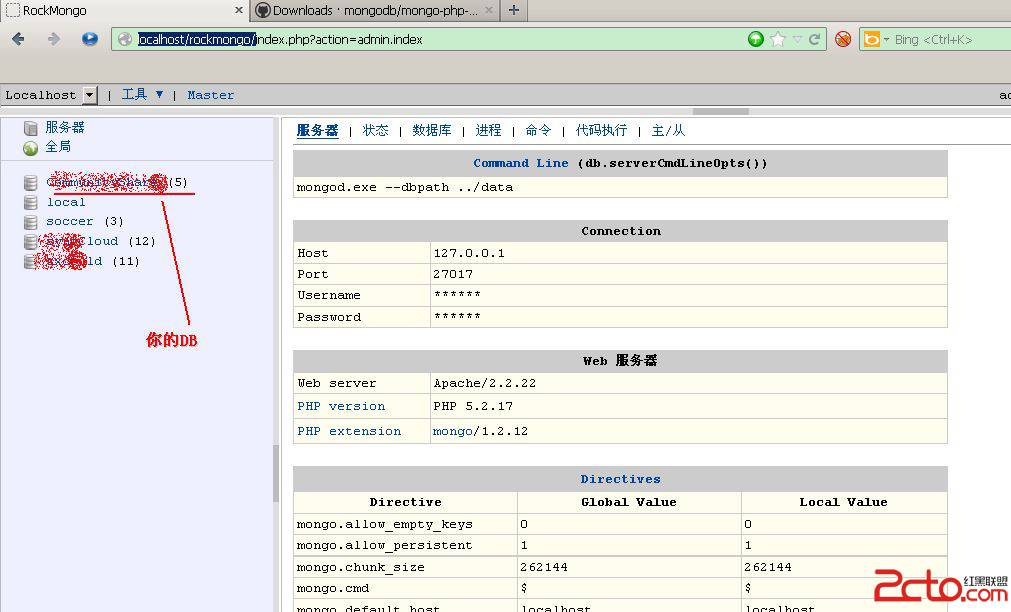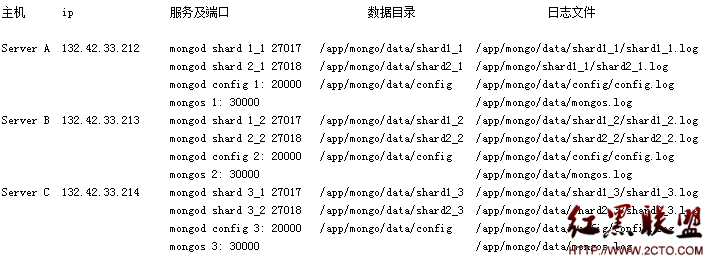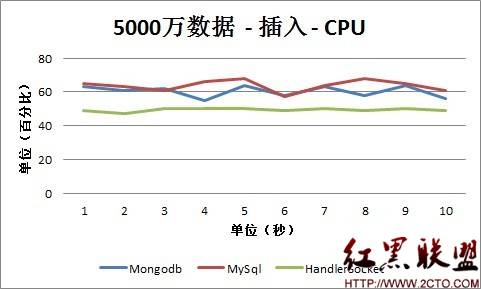mongodb的安装
1、安装MongoDB
curl -o http://fastdl.mongodb.org/linux/mongodb-linux-i686-2.0.0.tgz
tar -zxvf mongodb-linux-i686-2.0.0
2、启动MongoDB
./bin/mongod -dbpath=../data
./bin/mongo
3、实际操作
show dbs; 查看数据库
use admin 切换到管理员身份
db.addUser('username','pwd');
show collections; 查看当前用户下的所有表
db.system.users.find(); 查看所有用户
1.添加并验证用户
> use admin
> db.addUser("zjx","tsjianxin")
> db.auth("zjx","tsjianxin")
2.查看已存在的用户
> db.system.users.find()
3.现在来给另一个数据库51cv配置一个读写权限的用户
> use 51cv
> db.addUser("51cvrw","51cv")
..."readOnly" : false...
4.配置一个只读权限的用户
> use 51cv
> db.addUser("51cvr","51cv",true)
> db.system.users.find()
..."readOnly" : true...
5.删除用户
> use dbname (admin or 51cv ,etc)
> db.system.users.remove({user:"haha"})
> db.system.users.find()
6.用户登录数据库测试
for:mongod dbname -u uname -p password
mongo admin -u zjx -p tsjianxin
查询
db.image.find({}, {"url":1})
查看当前用户是否能访问数据库:
use db
db.auth('username','pwd'); 如果成功返回1,失败返回0
MongoDB基本使用
成功启动MongoDB后,再打开一个命令行窗口输入mongo,就可以进行数据库的一些操作。
输入help可以看到基本操作命令:
show dbs:显示数据库列表
show collections:显示当前数据库中的集合(类似关系数据库中的表)
show users:显示用户
use <db name>:切换当前数据库,这和MS-SQL里面的意思一样
db.help():显示数据库操作命令,里面有很多的命令
db.foo.help():显示集合操作命令,同样有很多的命令,foo指的是当前数据库下,一个叫foo的集合,并非真正意义上的命令
db.foo.find():对于当前数据库中的foo集合进行数据查找(由于没有条件,会列出所有数据)
db.foo.find( { a : 1 } ):对于当前数据库中的foo集合进行查找,条件是数据中有一个属性叫a,且a的值为1
MongoDB没有创建数据库的命令,但有类似的命令。
如:如果你想创建一个“myTest”的数据库,先运行use myTest命令,之后就做一些操作(如:db.createCollection('user')),这样就可以创建一个名叫“myTest”的数据库。
数据库常用命令
1、Help查看命令提示
help
db.help();
db.yourColl.help();
db.youColl.find().help();
rs.help();
2、切换/创建数据库
use yourDB; 当创建一个集合(table)的时候会自动创建当前数据库
3、查询所有数据库
show dbs;
4、删除当前使用数据库
db.dropDatabase();
5、从指定主机上克隆数据库
db.cloneDatabase(“127.0.0.1”); 将指定机器上的数据库的数据克隆到当前数据库
6、从指定的机器上复制指定数据库数据到某个数据库
db.copyDatabase("mydb", "temp", "127.0.0.1");将本机的mydb的数据复制到temp数据库中
7、修复当前数据库
db.repairDatabase();
8、查看当前使用的数据库
db.getName();
db; db和getName方法是一样的效果,都可以查询当前使用的数据库
9、显示当前db状态
db.stats();
10、当前db版本
db.version();
11、查看当前db的链接机器地址
db.getMongo();
Collection聚集集合
1、创建一个聚集集合(table)
db.createCollection(“collName”, {size: 20, capped: 5, max: 100});
2、得到指定名称的聚集集合(table)
db.getCollection("account");
3、得到当前db的所有聚集集合
db.getCollectionNames();
4、显示当前db所有聚集索引的状态
db.printCollectionStats();
用户相关
1、添加一个用户
db.addUser("name");
db.addUser("userName", "pwd123", true); 添加用户、设置密码、是否只读
2、数据库认证、安全模式
db.auth("userName", "123123");
3、显示当前所有用户
show users;
4、删除用户
db.removeUser("userName");
其他
1、查询之前的错误信息
db.getPrevError();
2、清除错误记录
db.resetError();
查看聚集集合基本信息
1、查看帮助 db.yourColl.help();
2、查询当前集合的数据条数 db.yourColl.count();
3、查看数据空间大小 db.userInfo.dataSize();
4、得到当前聚集集合所在的db db.userInfo.getDB();
5、得到当前聚集的状态 db.userInfo.stats();
6、得到聚集集合总大小 db.userInfo.totalSize();
7、聚集集合储存空间大小 db.userInfo.storageSize();
8、Shard版本信息 db.userInfo.getShardVersion()
9、聚集集合重命名 db.userInfo.renameCollection("users"); 将userInfo重命名为users
10、删除当前聚集集合 db.userInfo.drop();
聚集集合查询
1、查询所有记录
db.userInfo.find();
相当于:select* from userInfo;
默认每页显示20条记录,当显示不下的情况下,可以用it迭代命令查询下一页数据。注意:键入it命令不能带“;”
但是你可以设置每页显示数据的大小,用DBQuery.shellBatchSize= 50;这样每页就显示50条记录了。
2、查询去掉后的当前聚集集合中的某列的重复数据
db.userInfo.distinct("name");
会过滤掉name中的相同数据
相当于:select distict name from userInfo;
3、查询age = 22的记录
db.userInfo.find({"age": 22});
相当于: select * from userInfo where age = 22;
4、查询age > 22的记录
db.userInfo.find({age: {$gt: 22}});
相当于:select * from userInfo where age >22;
5、查询age < 22的记录
db.userInfo.find({age: {$lt: 22}});
相当于:select * from userInfo where age <22;
6、查询age >= 25的记录
db.userInfo.find({age: {$gte: 25}});
相当于:select * from userInfo where age >= 25;
7、查询age <= 25的记录
db.userInfo.find({age: {$lte: 25}});
8、查询age >= 23 并且 age <= 26
db.userInfo.find({age: {$gte: 23, $lte: 26}});
9、查询name中包含 mongo的数据
db.userInfo.find({name: /mongo/});
//相当于%%
select * from userInfo where name like ‘%mongo%’;
10、查询name中以mongo开头的
db.userInfo.find({name: /^mongo/});
select * from userInfo where name like ‘mongo%’;
11、查询指定列name、age数据
db.userInfo.find({}, {name: 1, age: 1});
相当于:select name, age from userInfo;
当然name也可以用true或false,当用ture的情况下河name:1效果一样,如果用false就是排除name,显示name以外的列信息。
12、查询指定列name、age数据, age > 25
db.userInfo.find({age: {$gt: 25}}, {name: 1, age: 1});
相当于:select name, age from userInfo where age >25;
13、按照年龄排序
升序:db.userInfo.find().sort({age: 1});
降序:db.userInfo.find().sort({age: -1});
14、查询name = zhangsan, age = 22的数据
db.userInfo.find({name: 'zhangsan', age: 22});
相当于:select * from userInfo where name = ‘zhangsan’ and age





